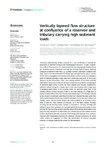Vertically layered flow structure at confluence of a reservoir and tributary carrying high sediment loads
| dc.contributor.author | Sun, Y | |
| dc.contributor.author | Li, J | |
| dc.contributor.author | Cao, Z | |
| dc.contributor.author | Borthwick, Alistair | |
| dc.date.accessioned | 2022-11-03T15:31:46Z | |
| dc.date.available | 2022-11-03T15:31:46Z | |
| dc.date.issued | 2022-08-26 | |
| dc.identifier.issn | 2296-6463 | |
| dc.identifier.issn | 2296-6463 | |
| dc.identifier.other | 924005 | |
| dc.identifier.uri | http://hdl.handle.net/10026.1/19837 | |
| dc.description.abstract |
<jats:p>Enhanced understanding of flow structure at a river confluence is essential for predictions of sediment transport and morphological evolution. To date, however, the confluent flow structure of a reservoir and tributary carrying high sediment loads has remained poorly understood, and may be vertically layered sharply, featuring subaqueous sediment-laden flow, i.e., turbidity currents underneath subaerial clear water. Here a recently established 2D double layer-averaged model, able to resolve the formation, propagation, and recession of turbidity currents, is used to investigate a series of idealized laboratory-scale cases and a prototype case study of the Guxian Reservoir on the Yellow River, China. Four primary patterns of the stable, vertically layered flow structure at a reservoir-tributary confluence are identified: 1) single layers of sediment-laden inflow in both the main channel and tributary, sustained by sufficient vertical mixing; 2) a double layer in the main channel and a single layer of sediment-laden inflow in the tributary, when the sediment-laden flow in the tributary suffices to block intrusion of flow in the main channel; 3) a single layer of sediment-laden inflow in the main channel and a double layer in the tributary, induced by the intrusion of sediment-laden flow from the main channel into clear-water flow with small discharge in the tributary; and 4) double layers in both the main channel and tributary, which may be further divided into three subpatterns, as turbidity current exists in both the main channel and tributary, or in the main channel (tributary) intruding into the tributary (main channel). In response to unsteady discharge and sediment inputs from upstream, the vertically layered flow structure evolves in time, and may fall into one of the patterns identified above. Although bed deformation in the long term may modify the confluent flow, the vertically layered flow pattern remains so far as the present cases are concerned. The findings have implications for sediment transport and morphological evolution at a reservoir–tributary confluence, for which further studies are suggested to inform the optimization of reservoir operation schemes to mitigate capacity loss caused by sedimentation.</jats:p> | |
| dc.format.extent | 924005- | |
| dc.language.iso | en | |
| dc.publisher | Frontiers Media | |
| dc.title | Vertically layered flow structure at confluence of a reservoir and tributary carrying high sediment loads | |
| dc.type | journal-article | |
| dc.type | Journal Article | |
| plymouth.volume | 10 | |
| plymouth.publication-status | Published online | |
| plymouth.journal | Frontiers in Earth Science | |
| dc.identifier.doi | 10.3389/feart.2022.924005 | |
| plymouth.organisational-group | /Plymouth | |
| plymouth.organisational-group | /Plymouth/Faculty of Science and Engineering | |
| plymouth.organisational-group | /Plymouth/Faculty of Science and Engineering/School of Engineering, Computing and Mathematics | |
| plymouth.organisational-group | /Plymouth/Users by role | |
| plymouth.organisational-group | /Plymouth/Users by role/Academics | |
| dcterms.dateAccepted | 2022-07-25 | |
| dc.rights.embargodate | 2022-11-4 | |
| dc.identifier.eissn | 2296-6463 | |
| dc.rights.embargoperiod | Not known | |
| rioxxterms.versionofrecord | 10.3389/feart.2022.924005 | |
| rioxxterms.licenseref.uri | http://www.rioxx.net/licenses/all-rights-reserved | |
| rioxxterms.type | Journal Article/Review |


